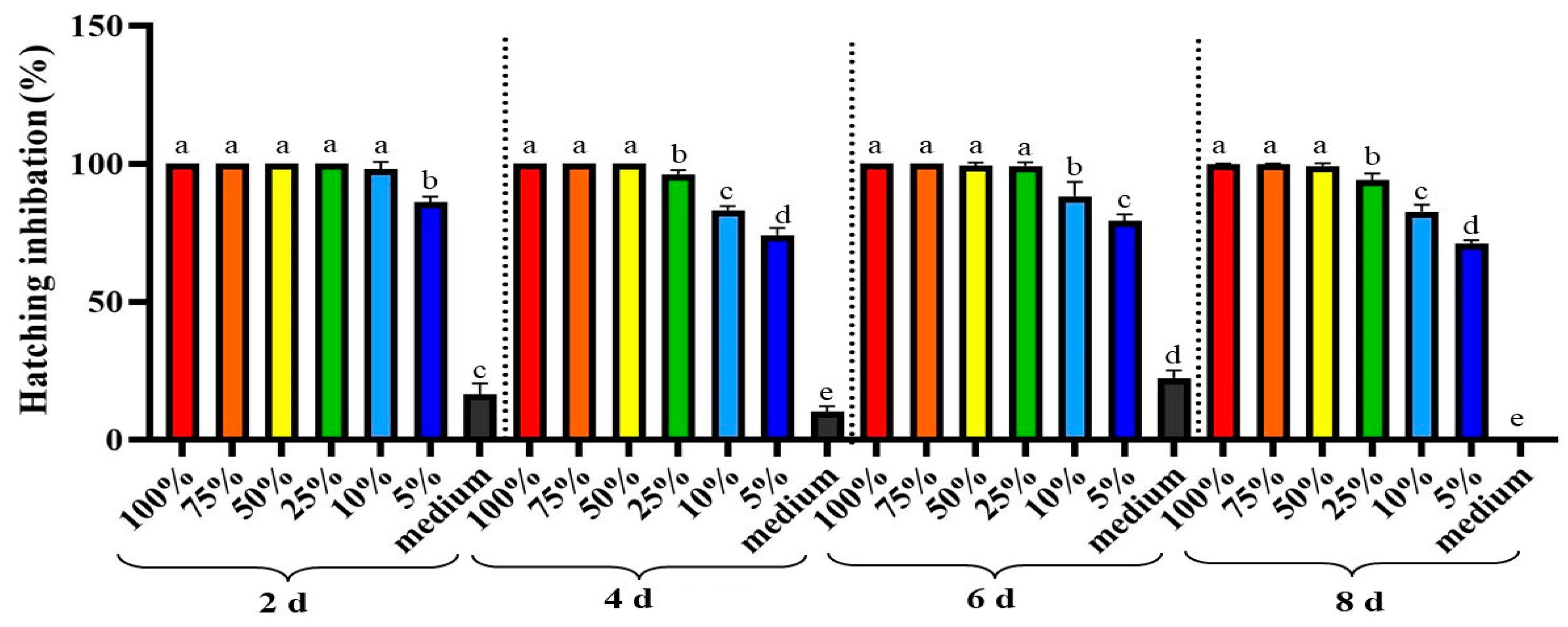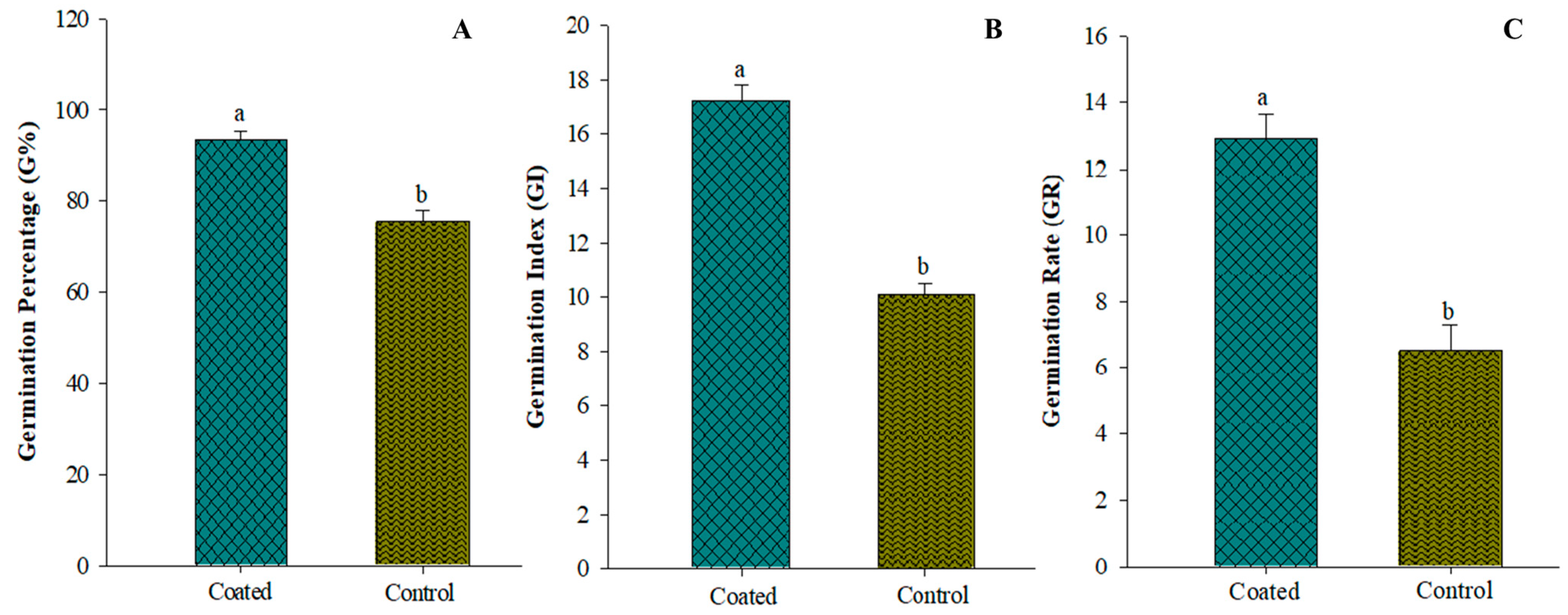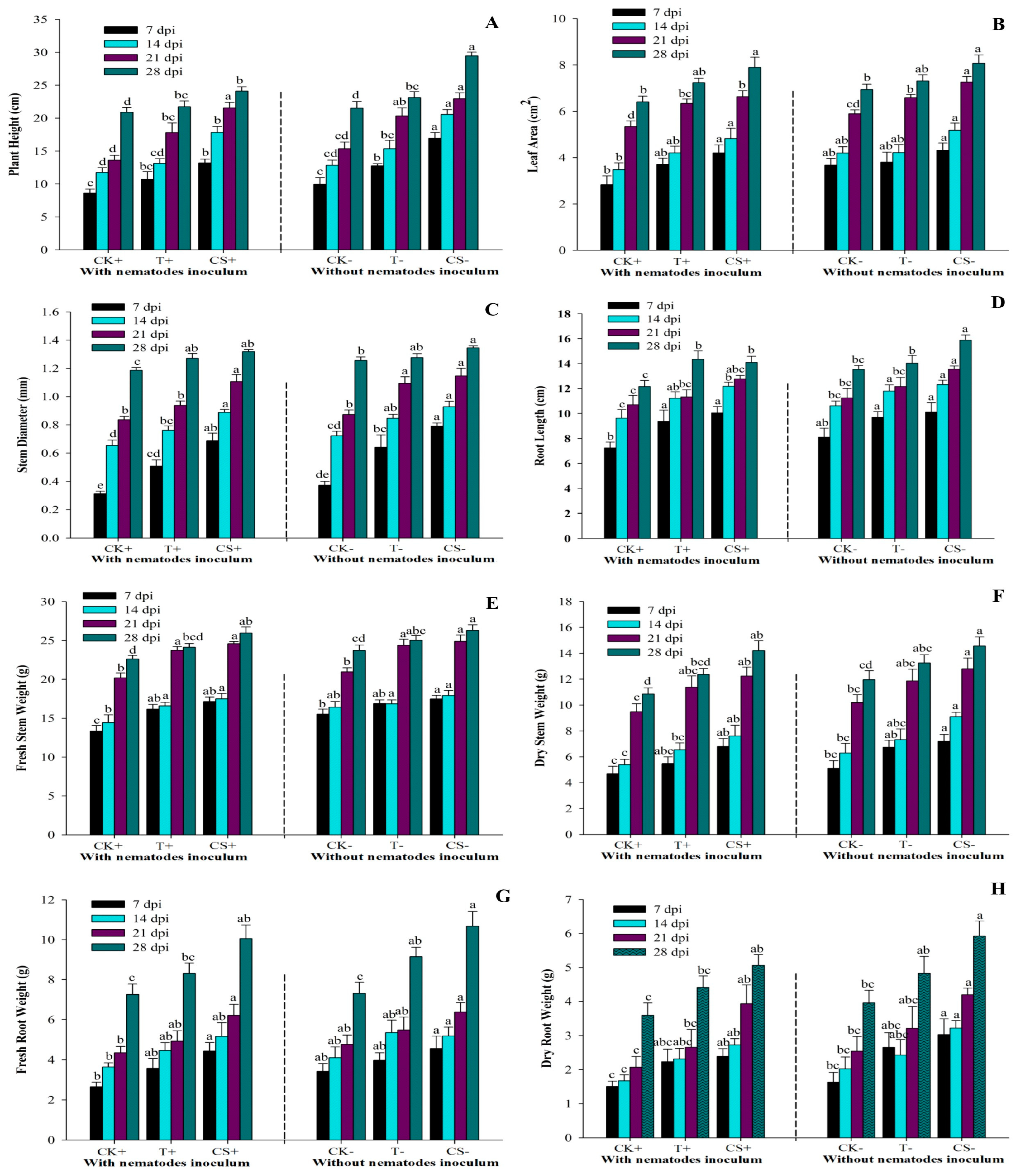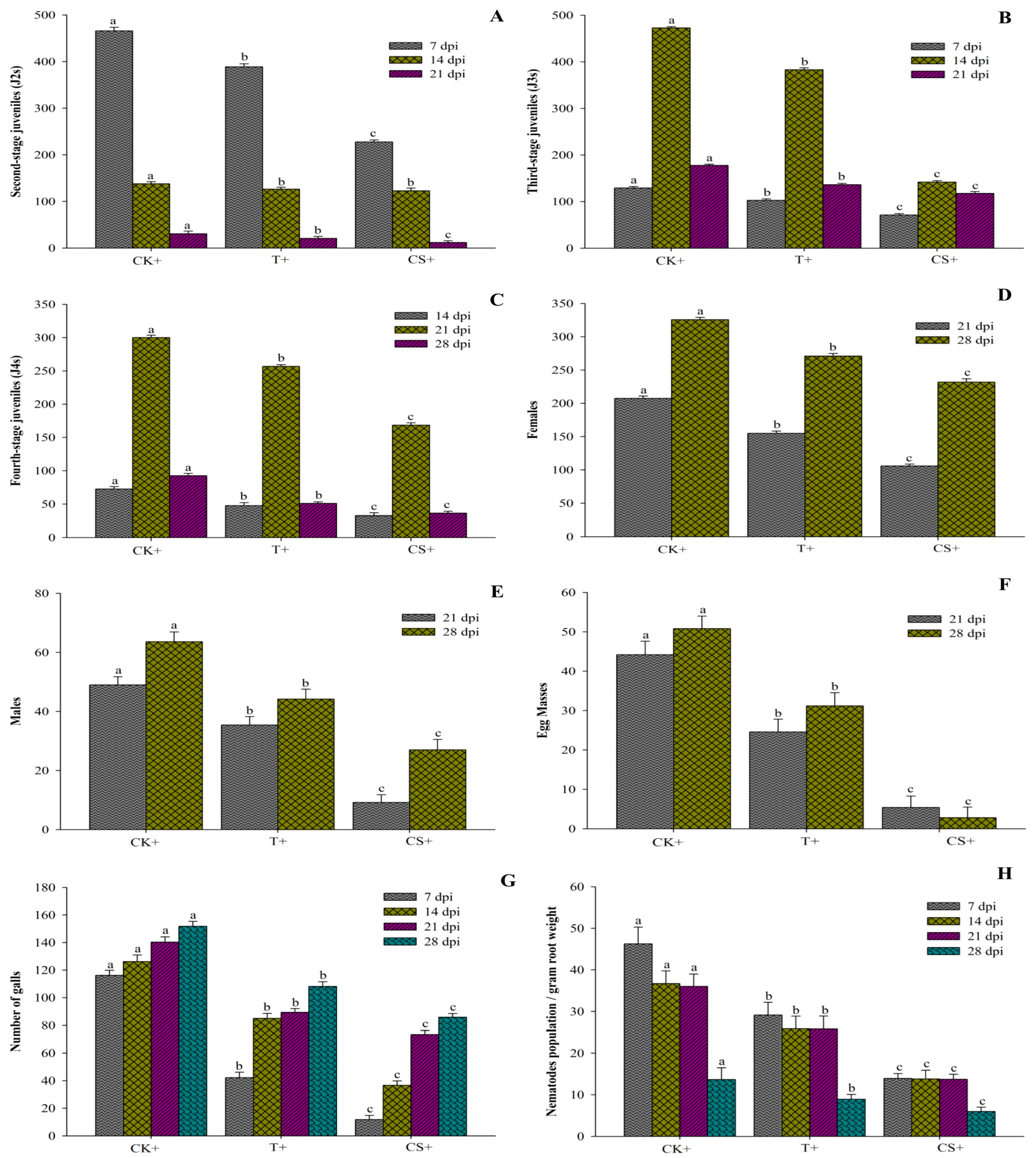Efficacy of Aspergillus tubingensis GX3′ Fermentation against Meloidogyne enterolobii in Tomato (Solanum lycopersicum L.)
Abstract
1. Introduction
2. Results
2.1. Effect of Fermentation Filtrate on M. enterolobii Juveniles (J2s)
2.2. Effect of Fermentation Filtrate on Meloidogyne enterolobii Eggs Hatching
2.3. Hatching Inhibition
2.4. Probit Analysis of Ovicidal and Larvicidal Assays
2.5. Model Validation of Ovicidal and Larvicidal Assays
2.6. Greenhouse Experiment
2.6.1. Seed Germination
2.6.2. Growth Parameters
2.6.3. Nematode Infection
3. Discussion
4. Materials and Methods
4.1. The Activation of the Fungus Strain and the Preparation of Fermentation Broth
4.2. Nematode Culture
4.3. Effect of Fermentation Filtrate on M. enterolobii Juveniles (J2s)
4.4. Effect of Fermentation Filtrate on M. enterolobii Egg Hatching
4.5. Sterilization of Seeds and Seeds Coating
4.6. Greenhouse Experiments
Growth Index Observation and Nematodes Infection Determination
4.7. Model Validations
4.8. Statistical Analysis
5. Conclusions
Author Contributions
Funding
Data Availability Statement
Conflicts of Interest
References
- Sikandar, A.; Khanum, T.A.; Wang, Y. Biodiversity and community analysis of plant-parasitic and free-living nematodes associated with maize and other rotational crops from Punjab, Pakistan. Life 2021, 11, 1426. [Google Scholar] [CrossRef]
- Elling, A.A. Major emerging problems with minor Meloidogyne species. Phytopathology 2013, 103, 1092–1102. [Google Scholar] [CrossRef]
- Sikandar, A.; Zhang, M.; Wang, Y.; Zhu, X.; Liu, X.; Fan, H.; Xuan, Y.; Chen, L.; Duan, Y. In vitro evaluation of Penicillium chrysogenum Snef1216 against Meloidogyne incognita (root-knot nematode). Sci. Rep. 2020, 10, 8342. [Google Scholar] [CrossRef]
- Sikandar, A.; Zhang, M.; Wang, Y.; Zhu, X.; Liu, X.; Fan, H.; Xuan, Y.; Chen, L.; Duan, Y. Review article: Meloidogyne incognita (root-knot nemtaode) a risk to agriculture. Appl. Ecol. Environ. Res. 2020, 18, 1679–1690. [Google Scholar] [CrossRef]
- Shilpa; Sharma, P.; Thakur, V.; Sharma, A.; Rana, R.; Kumar, P. A status-quo review on management of root knot nematode in tomato. J. Hortic. Sci. Biotechnol. 2022, 97, 403–416. [Google Scholar] [CrossRef]
- Archidona-Yuste, A.; Cantalapiedra-Navarrete, C.; Liebanas, G.; Rapoport, H.F.; Castillo, P.; Palomares-Rius, J.E. Diversity of root-knot nematodes of the genus Meloidogyne Göeldi, 1892 (Nematoda: Meloidogynidae) associated with olive plants and environmental cues regarding their distribution in southern Spain. PLoS ONE 2018, 13, e0198236. [Google Scholar] [CrossRef] [PubMed]
- Sikandar, A.; Jia, L.M.; Wu, H.Y.; Yang, S. Meloidogyne enterolobii risk to agriculture, its present status and future prospective for management. Front. Plant Sci. 2023, 13, 1093657. [Google Scholar] [CrossRef] [PubMed]
- Hallmann, J.; Kiewnick, S. Virulence of Meloidogyne incognita populations and Meloidogyne enterolobii on resistant cucurbitaceous and solanaceous plant genotypes. J. Plant Dis. Prot. 2018, 125, 415–424. [Google Scholar] [CrossRef]
- Castagnone-Sereno, P. Meloidogyne enterolobii (M. mayaguensis): Profile of an emerging, highly pathogenic, root-knot nematode species. Nematology 2012, 14, 133–138. [Google Scholar] [CrossRef]
- Abd-Elgawad, M.M.M. Optimizing safe approaches to manage plant-parasitic nematodes. Plants 2021, 10, 1911. [Google Scholar] [CrossRef]
- Jia, L.; Wang, Y.; Gao, F.; Chen, Q.; Yang, S.; Wu, H. First Report of the Root-Knot Nematode Meloidogyne enterolobii infecting Acalypha australis in China. Plant Dis. 2022, 107, 587. [Google Scholar] [CrossRef] [PubMed]
- Gomes, V.M.; Souza, R.M.; Almeida, A.M.; Dolinski, C. Relationships between M. enterolobii and F. solani: Spatial and temporal dynamics in the occurrence of guava decline. Nematoda 2014, 1, e01014. [Google Scholar] [CrossRef]
- Desaeger, J.; Wram, C.; Zasada, I. New reduced-risk agricultural nematicides-rationale and review. J. Nematol. 2020, 52, 1–16. [Google Scholar] [CrossRef] [PubMed]
- Gatahi, D.M. Challenges and opportunities in tomato production chain and sustainable standards. Int. J. Hortic. Sci. Technol. 2020, 7, 235–262. [Google Scholar] [CrossRef]
- Li, W.; Ren, L.; Li, Q.; Zhang, D.; Jin, X.; Fang, W.; Yan, D.; Li, Y.; Wang, Q.; Cao, A. Evaluation of ethylicin as a potential soil fumigant in commercial tomato production in China. Sci. Total Environ. 2023, 854, 158520. [Google Scholar] [CrossRef]
- Caboni, P.; Ntalli, N.G.; Aissani, N.; Cavoski, I.; Angioni, A. Nematicidal activity of (E,E)-2, 4-decadienal and (E)-2-decenal from Ailanthus altissima against Meloidogyne javanica. J. Agric. Food Chem. 2012, 60, 1146–1151. [Google Scholar] [CrossRef]
- Adeola, F.O. Global impact of chemicals and toxic substances on human health and the environment. In Handbook of Global Health; Haring, R., Kickbusch, I., Ganten, D., Moeti, M., Eds.; Springer International Publishing: Cham, Switzerland, 2020; pp. 1–30. [Google Scholar] [CrossRef]
- Riascos-Ortiz, D.; Mosquera-Espinosa, A.T.; Varón de Agudelo, F.; Oliveira, C.M.G.; Muñoz Flórez, J.E. Non-conventional management of plant-parasitic nematodes in musaceas crops. In Sustainable Management of Nematodes in Agriculture, Vol. 1: Organic Management; Chaudhary, K.K., Meghvansi, M.K., Eds.; Springer International Publishing: Cham, Switzerland, 2022; Volume 1, pp. 381–422. [Google Scholar]
- Ahmad, G.; Khan, A.; Khan, A.A.; Ali, A.; Mohhamad, H.I. Biological control: A novel strategy for the control of the plant parasitic nematodes. Antonie Leeuwenhoek 2021, 114, 885–912. [Google Scholar] [CrossRef]
- Bhat, A.A.; Shakeel, A.; Waqar, S.; Handoo, Z.A.; Khan, A.A. Microbes vs. nematodes: Insights into biocontrol through antagonistic organisms to control root-knot nematodes. Plants 2023, 12, 451. [Google Scholar] [CrossRef]
- Zhang, H.; Xiong, P.; Yang, S.; Yu, J. Renewable energy utilization, green finance and agricultural land expansion in China. Resour. Policy 2023, 80, 103163. [Google Scholar] [CrossRef]
- Liu, T.; Yu, L.; Chen, X.; Wu, H.; Lin, H.; Li, C.; Hou, J. Environmental laws and ecological restoration projects enhancing ecosystem services in China: A meta-analysis. J. Environ. Manag. 2023, 327, 116810. [Google Scholar] [CrossRef]
- Li, X.; Zeng, S.; Wisniewski, M.; Droby, S.; Yu, L.; An, F.; Leng, Y.; Wang, C.; Li, X.; He, M. Current and future trends in the biocontrol of postharvest diseases. Crit. Rev. Food Sci. Nutr. 2022, 1–13. [Google Scholar] [CrossRef]
- Li, J.; Zou, C.; Xu, J.; Ji, X.; Niu, X.; Yang, J.; Huang, X.; Zhang, K.-Q. Molecular mechanisms of nematode-nematophagous microbe interactions: Basis for biological control of plant-parasitic nematodes. Annu. Rev. Phytopathol. 2015, 53, 67–95. [Google Scholar] [CrossRef] [PubMed]
- Zhang, Y.; Li, S.; Li, H.; Wang, R.; Zhang, K.-Q.; Xu, J. Fungi–nematode interactions: Diversity, ecology, and biocontrol prospects in agriculture. J. Fungi 2020, 6, 206. [Google Scholar] [CrossRef]
- Grabka, R.; d’Entremont, T.W.; Adams, S.J.; Walker, A.K.; Tanney, J.B.; Abbasi, P.A.; Ali, S. Fungal endophytes and their role in agricultural plant protection against pests and pathogens. Plants 2022, 11, 384. [Google Scholar] [CrossRef]
- Sikandar, A.; Zhang, M.; Yang, R.; Liu, D.; Zhu, X.; Liu, X.; Fan, H.; Duan, Y.; Wang, Y. Analysis of gene expression in cucumber roots interacting with Penicillium chrysogenum strain Snef1216 through seed coating, which induced resistance to Meloidogyne incognita. Nematology 2021, 24, 121–135. [Google Scholar] [CrossRef]
- Sikandar, A.; Zhang, M.; Wang, Y.; Zhu, X.; Liu, X.; Fan, H.; Xuan, Y.; Chen, L.; Duan, Y. Mycochemical Screening and Analysis, Antioxidant Activity, and Biochemical Composition of Fermentation Strain Snef1216 (Penicillium chrysogenum). J. Anal. Methods Chem. 2020, 2020, 3073906. [Google Scholar] [CrossRef] [PubMed]
- Tsai, A.Y.-L.; Oota, M.; Sawa, S. Chemotactic host-finding strategies of plant endoparasites and endophytes. Front. Plant Sci. 2020, 11, 1167. [Google Scholar] [CrossRef] [PubMed]
- Abdelwahab, M.F.; Kurtán, T.; Mándi, A.; Müller, W.E.; Fouad, M.A.; Kamel, M.S.; Liu, Z.; Ebrahim, W.; Daletos, G.; Proksch, P. Induced secondary metabolites from the endophytic fungus Aspergillus versicolor through bacterial co-culture and OSMAC approaches. Tetrahedron Lett. 2018, 59, 2647–2652. [Google Scholar] [CrossRef]
- Nielsen, K.F.; Mogensen, J.M.; Johansen, M.; Larsen, T.O.; Frisvad, J.C. Review of secondary metabolites and mycotoxins from the Aspergillus niger group. Anal. Bioanal. Chem. 2009, 395, 1225–1242. [Google Scholar] [CrossRef]
- Lamboni, Y.; Nielsen, K.F.; Linnemann, A.R.; Gezgin, Y.; Hell, K.; Nout, M.J.; Smid, E.J.; Tamo, M.; van Boekel, M.A.; Hoof, J.B. Diversity in secondary metabolites including mycotoxins from strains of Aspergillus section Nigri isolated from raw cashew nuts from Benin, West Africa. PLoS ONE 2016, 11, e0164310. [Google Scholar] [CrossRef]
- Hung, R.; Rutgers, S.L. Applications of Aspergillus in plant growth promotion. In New and Future Developments in Microbial Biotechnology and Bioengineering; Gupta, V.K., Ed.; Elsevier: Amsterdam, The Netherlands, 2016; pp. 223–227. [Google Scholar] [CrossRef]
- Seong, J.; Shin, J.; Kim, K.; Cho, B.-K. Microbial production of nematicidal agents for controlling plant-parasitic nematodes. Process Biochem. 2021, 108, 69–79. [Google Scholar] [CrossRef]
- El-Hawary, S.S.; Moawad, A.S.; Bahr, H.S.; Abdelmohsen, U.R.; Mohammed, R. Natural product diversity from the endophytic fungi of the genus Aspergillus. RSC Adv. 2020, 10, 22058–22079. [Google Scholar] [CrossRef]
- Yeon, J.; Park, A.R.; Kang, M.; Nguyen, V.T.; Lee, Y.; Kim, H.M.; Park, H.W.; Ha, P.; Koo, Y.; Kim, J.-C. Control of root-knot nematodes on tomato by eliciting resistance through Aspergillus niger-derived oxalic acid. J. Pest Sci. 2022, 96, 1287–1299. [Google Scholar] [CrossRef]
- Siddiqui, I.; Shaukat, S.; Khan, A. Differential impact of some Aspergillus species on Meloidogyne javanica biocontrol by Pseudomonas fluorescens strain CHA0. Lett. Appl. Microbiol. 2004, 39, 74–83. [Google Scholar] [CrossRef] [PubMed]
- Xu, C.; Xu, K.; Yuan, X.-L.; Ren, G.-W.; Wang, X.-Q.; Li, W.; Deng, N.; Wang, X.-F.; Zhang, P. Characterization of diketopiperazine heterodimers as potential chemical markers for discrimination of two dominant black aspergilli, Aspergillus niger and Aspergillus tubingensis. Phytochemistry 2020, 176, 112399. [Google Scholar] [CrossRef]
- Kriaa, M.; Hammami, I.; Sahnoun, M.; Azebou, M.C.; Triki, M.A.; Kammoun, R. Biocontrol of tomato plant diseases caused by Fusarium solani using a new isolated Aspergillus tubingensis CTM 507 glucose oxidase. Comptes Rendus Biol. 2015, 338, 666–677. [Google Scholar] [CrossRef] [PubMed]
- Krishna, P.; Reddy, M.S.; Patnaik, S. Aspergillus tubingensis reduces the pH of the bauxite residue (red mud) amended soils. Water Air Soil Poll. 2005, 167, 201–209. [Google Scholar] [CrossRef]
- Kriaa, M.; Mnafgui, K.; Belhadj, S.; El Feki, A.; Kammoun, R. The Developmental Evaluation of Aspergillus Tubingensis CTM 507 Glucose Oxidase Toxicity in Wistar Rats. J. Food Saf. 2015, 35, 263–269. [Google Scholar] [CrossRef]
- Jin, N.; Liu, S.-M.; Peng, H.; Huang, W.-K.; Kong, L.-A.; Wu, Y.-H.; Chen, Y.-P.; Ge, F.-Y.; Jian, H.; Peng, D.-L. Isolation and characterization of Aspergillus niger NBC001 underlying suppression against Heterodera glycines. Sci. Rep. 2019, 9, 591. [Google Scholar] [CrossRef]
- Sharapova, I. Prospects of using entomopathogenic fungus in development of a biopesticide product with nematicidal activity. Biocatal. Agric. Biotechnol. 2019, 19, 101098. [Google Scholar] [CrossRef]
- Wu, H.Y.; Zhang, L.Y.; Zhou, X.B. Effects of Myrothecium verrucaria ZW-2 fermentation filtrates on various plant-parasitic nematodes. J. Plant Dis. Prot. 2020, 127, 545–552. [Google Scholar] [CrossRef]
- Wang, L.; Qin, Y.; Fan, Z.; Gao, K.; Zhan, J.; Xing, R.; Liu, S.; Li, P. Novel lead compound discovery from Aspergillus fumigatus 1T-2 against Meloidogyne incognita based on a chemical ecology study. J. Agric. Food Chem. 2022, 70, 4644–4657. [Google Scholar] [CrossRef] [PubMed]
- Fan, H.; Yao, M.; Wang, H.; Zhao, D.; Zhu, X.; Wang, Y.; Liu, X.; Duan, Y.; Chen, L. Isolation and effect of Trichoderma citrinoviride Snef1910 for the biological control of root-knot nematode, Meloidogyne incognita. BMC Microbiol. 2020, 20, 299. [Google Scholar] [CrossRef] [PubMed]
- Jang, J.Y.; Choi, Y.H.; Shin, T.S.; Kim, T.H.; Shin, K.-S.; Park, H.W.; Kim, Y.H.; Kim, H.; Choi, G.J.; Jang, K.S. Biological control of Meloidogyne incognita by Aspergillus niger F22 producing oxalic acid. PLoS ONE 2016, 11, e0156230. [Google Scholar] [CrossRef]
- Devi, G.; Bora, L. Effect of some biocontrol agents against root-knot nematode (Meloidogyne incognita race2). Int. J. Environ. Agric. Biotechnol. 2018, 3, 265260. [Google Scholar] [CrossRef]
- Hu, Y.; Zhang, W.; Zhang, P.; Ruan, W.; Zhu, X. Nematicidal activity of chaetoglobosin A poduced by Chaetomium globosum NK102 against Meloidogyne incognita. J. Agric. Food Chem. 2013, 61, 41–46. [Google Scholar] [CrossRef]
- Youssef, M.M.A.; El-Nagdi, W.M.A.; Lotfy, D.E.M. Evaluation of the fungal activity of Beauveria bassiana, Metarhizium anisopliae and Paecilomyces lilacinus as biocontrol agents against root-knot nematode, Meloidogyne incognita on cowpea. Bull. Natl. Res. Cent. 2020, 44, 112. [Google Scholar] [CrossRef]
- Chenthamara, K.; Druzhinina, I.S. Ecological Genomics of Mycotrophic Fungi. In Environmental and Microbial Relationships; Druzhinina, I.S., Kubicek, C.P., Eds.; Springer International Publishing: Cham, Switzerland, 2016; pp. 215–246. [Google Scholar] [CrossRef]
- Ahmad, R.; Sidi, B.; Endrawati, D.; Ekawasti, F. Paecilomyces lilacinus and P. variotii as a predator of nematode and trematode eggs. In Proceedings of the IOP Conference Series: Earth and Environmental Science; IOP Science: Bogor, Indonesia, 2019; p. 12056. [Google Scholar]
- Reithner, B.; Ibarra-Laclette, E.; Mach, R.L.; Herrera-Estrella, A. Identification of mycoparasitism-related genes in Trichoderma atroviride. Appl. Environ. Microbiol. 2011, 77, 4361–4370. [Google Scholar] [CrossRef]
- Troian, R.F.; Steindorff, A.S.; Ramada, M.H.S.; Arruda, W.; Ulhoa, C.J. Mycoparasitism studies of Trichoderma harzianum against Sclerotinia sclerotiorum: Evaluation of antagonism and expression of cell wall-degrading enzymes genes. Biotechnol. Lett. 2014, 36, 2095–2101. [Google Scholar] [CrossRef]
- Shen, Z.; Zhang, S.; Xu, B. Trichoderma longibrachiatum T6: A nematocidal activity of endochitinase gene exploration and its function identification. Int. J. Biol. Macromol. 2022, 223, 1641–1652. [Google Scholar] [CrossRef]
- Cairns, T.C.; Zheng, X.; Zheng, P.; Sun, J.; Meyer, V. Turning inside out: Filamentous fungal secretion and its applications in biotechnology, agriculture, and the clinic. J. Fungi 2021, 7, 535. [Google Scholar] [CrossRef] [PubMed]
- Ceci, A.; Pinzari, F.; Russo, F.; Maggi, O.; Persiani, A.M. Saprotrophic soil fungi to improve phosphorus solubilisation and release: In vitro abilities of several species. Ambio 2018, 47, 30–40. [Google Scholar] [CrossRef] [PubMed]
- Alves, G.S.; Bertini, S.C.B.; Barbosa, B.B.; Pimentel, J.P.; Junior, V.A.R.; de Oliveira Mendes, G.; Azevedo, L.C.B. Fungal endophytes inoculation improves soil nutrient availability, arbuscular mycorrhizal colonization and common bean growth. Rhizosphere 2021, 18, 100330. [Google Scholar] [CrossRef]
- Kappel, L.; Kosa, N.; Gruber, S. The multilateral efficacy of chitosan and Trichoderma on sugar beet. J. Fungi 2022, 8, 137. [Google Scholar] [CrossRef]
- Sikandar, A.; Zhang, M.; Zhu, X.; Wang, Y.; Ahmed, M.; Iqbal, M.; Javeed, A.; Xuan, Y.; Fan, H.; Liu, X. Efficacy of Penicillium chrysogenum strain Snef1216 against root-knot nematodes (Meloidogyne incognita) in cucumber (Cucumis sativus L.) under greenhouse conditions. Appl. Ecol. Environ. Res. 2019, 17, 12451–12464. [Google Scholar] [CrossRef]
- Baazeem, A.; Alorabi, M.; Manikandan, P.; Alotaibi, S.S.; Almanea, A.; Abdel-Hadi, A.; Vijayaraghavan, P.; Raj, S.R.F.; Kim, Y.O.; Kim, H.-J. Paecilomyces formosus MD12, a biocontrol agent to treat Meloidogyne incognita on brinjal in green house. J. Fungi 2021, 7, 632. [Google Scholar] [CrossRef]
- Philbrick, A.N.; Adhikari, T.B.; Louws, F.J.; Gorny, A.M. Meloidogyne enterolobii, a major threat to tomato production: Current status and future prospects for its management. Front. Plant Sci. 2020, 11, 606395. [Google Scholar] [CrossRef] [PubMed]
- Zhao, J.; Liu, W.; Liu, D.; Lu, C.; Zhang, D.; Wu, H.; Dong, D.; Meng, L. Identification and evaluation of Aspergillus tubingensis as a potential biocontrol agent against grey mould on tomato. J. Gen. Plant Pathol. 2018, 84, 148–159. [Google Scholar] [CrossRef]
- Nesha, R.; Siddiqui, Z.A. Effects of Paecilomyces lilacinus and Aspergillus niger alone and in combination on the growth, chlorophyll contents and soft rot disease complex of carrot. Sci. Hortic. 2017, 218, 258–264. [Google Scholar] [CrossRef]
- Liu, Y.; Ding, Z.; Peng, D.-l.; Liu, S.-m.; Kong, L.-a.; Peng, H.; Xiang, C.; Li, Z.-c.; Huang, W.-k. Evaluation of the biocontrol potential of Aspergillus welwitschiae against the root-knot nematode Meloidogyne graminicola in rice (Oryza sativa L.). J. Integr. Agric. 2019, 18, 2561–2570. [Google Scholar] [CrossRef]
- Wu, H.Y.; de Oliveira Silva, J.; Becker, J.S.; Becker, J.O. Fluazaindolizine mitigates plant-parasitic nematode activity at sublethal dosages. J. Pest Sci. 2021, 94, 573–583. [Google Scholar] [CrossRef]
- Aldesuquy, H.; Baka, Z.; Mickky, B. Kinetin and spermine mediated induction of salt tolerance in wheat plants: Leaf area, photosynthesis and chloroplast ultrastructure of flag leaf at ear emergence. Egypt J. Basic. Appl. Sci. 2014, 1, 77–87. [Google Scholar] [CrossRef]
- Debaeke, P.; Attia, F.; Champolivier, L.; Dejoux, J.F.; Micheneau, A.; Bitar, A.A.; Trépos, R. Forecasting sunflower grain yield using remote sensing data and statistical models. Eur. J. Agron. 2023, 142, 126677. [Google Scholar] [CrossRef]






| Fermentation | Mortality of M. enterolobii Juveniles | ||||
|---|---|---|---|---|---|
| 6 h | 12 h | 24 h | 48 h | 72 h | |
| 100% fermentation | 22.6 ± 3.05 a | 47.2 ± 5.49 a | 78.8 ± 3.49 a | 99.0 ± 1.41 a | 100.0 ± 0 a |
| 75% fermentation | 14.2 ± 2.39 b | 35.6 ± 3.91 b | 51.6 ± 4.22 b | 87.0 ± 3.16 b | 100.0 ± 0 a |
| 50% fermentation | 10.6 ± 2.41 c | 25.4 ± 3.05 c | 37.0 ± 2.55 c | 59.8 ± 6.76 c | 97.8 ± 2.49 a |
| 25% fermentation | 6.0 ± 1.58 d | 17.2 ± 3.42 d | 25.0 ± 3.87 d | 32.4 ± 3.44 d | 77.4 ± 4.39 b |
| 10% fermentation | 2.0 ± 1.00 e | 11.2 ± 1.79 e | 15.8 ± 3.27 e | 19.6 ± 2.07 e | 37.2 ± 4.49 c |
| 5% fermentation | 0.6 ± 0.55 e | 4.8 ± 1.64 f | 11.4 ± 3.21 f | 14.6 ± 3.78 f | 26.8 ± 2.59 d |
| Cazpek Medium | 0 ± 0 e | 0 ± 0 g | 2.0 ± 1.58 g | 3.6 ± 1.34 g | 8.8 ± 1.48 e |
| Distilled water | 0 ± 0 e | 0 ± 0 g | 1.8 ± 1.30 g | 4.2 ± 1.30 g | 8.0 ± 1.58 e |
| Fermentation | M. enterolobii Eggs Hatching | |||
|---|---|---|---|---|
| 2 d | 4 d | 6 d | 8 d | |
| 100% fermentation | 0 ± 0 d | 0 ± 0 f | 0 ± 0 e | 0.1 ± 0.22 f |
| 75% fermentation | 0 ± 0 d | 0 ± 0 f | 0.1 ± 0 e | 0.2 ± 0.45 f |
| 50% fermentation | 0 ± 0 d | 0 ± 0 f | 0.4 ± 0.55 e | 0.6 ± 0.89 f |
| 25% fermentation | 0 ± 0 d | 2.2 ± 2.49 e | 2.8 ± 2.39 e | 5.4 ± 4.51 e |
| 10% fermentation | 0.6 ± 0.5 d | 8.4 ± 1.67 d | 10.4 ± 2.07 d | 16.0 ± 3.32 d |
| 5% fermentation | 3.4 ± 1.67 c | 13.2 ± 3.27 c | 18.6 ± 3.85 c | 26.6 ± 4.04 c |
| Cazpek Medium | 20.6 ± 2.88 b | 46.0 ± 4.12 b | 68.8 ± 6.94 b | 87.2 ± 5.26 b |
| Distilled water | 24.8 ± 3.56 a | 51.6 ± 3.78 z | 87.2 ± 4.55 a | 92.0 ± 2.92 a |
| Assay | Time (h) | LC50 % (95% CI) | LC90 % (95% CI) | Slop ± S.E | x2 |
|---|---|---|---|---|---|
| Larvicidal assay | 6 | 437.76 (322.13–659.92) | 4357.15 (2385.87–9866.99) | 1.28 ± 0.10 | 3.73 |
| 12 | 141.39 (101.32–230.21) | 1693.06 (795.48–5626.89) | 1.19 ± 0.10 | 16.56 | |
| 24 | 59.22 (35.81–120.05) | 413.67 (173.92–6415.08) | 1.52 ± 0.32 | 91.80 | |
| 48 | 39.71 (22.50–52.34) | 84.39 (63.16–172.71) | 3.91 ± 0.87 | 111.04 | |
| 72 | 13.09 (9.61–16.65) | 34.89 (27.06–49.76) | 3.01 ± 0.33 | 42.48 |
| Assay | Time (d) | EC50 % (95% CI) | EC90 % (95% CI) | Slop ± S.E | x2 |
|---|---|---|---|---|---|
| Ovicidal assay | 2 | 2.36 (1.40–3.16) | 5.97 (4.84–7.32) | 3.19 ± 0.54 | 0.12 |
| 4 | 2.92 (2.28–3.56) | 12.05 (10.42–14.05) | 2.08 ± 0.15 | 10.90 | |
| 6 | 2.32 (2.03–2.62) | 10.40 (9.33–11.65) | 1.97 ± 0.09 | 9.19 | |
| 8 | 3.55 (2.34–4.82) | 13.74 (10.23–20.26) | 2.18 ± 0.23 | 32.81 |
| Fermentation | Larvicidal | Ovicidal | ||||
|---|---|---|---|---|---|---|
| R2 | RMSE | Regression Eq. | R2 | RMSE | Regression Eq. | |
| 100% | 0.93 | 7.944 | y = 20.66x + 7.54 | 0.60 | 0.024 | y = 0.03x − 0.05 |
| 75% | 0.98 | 4.307 | y = 22.3x − 9.22 | 0.60 | 0.049 | y = 0.06x − 0.1 |
| 50% | 0.94 | 7.381 | y = 20.88x − 16.52 | 0.90 | 0.075 | y = 0.22x − 0.3 |
| 25% | 0.83 | 10.08 | y = 15.8x − 15.8 | 0.95 | 0.371 | y = 1.68x − 1.6 |
| 10% | 0.92 | 3.280 | y = 7.88x − 6.48 | 0.95 | 1.061 | y = 4.82x − 3.2 |
| 5% | 0.95 | 2.021 | y = 6.22x − 7.02 | 0.99 | 0.807 | y = 7.5x − 3.3 |
| Cazpek medium | 0.85 | 1.264 | y = 2.12x − 3.48 | 0.99 | 1.576 | y = 22.26x − 5 × 10−14 |
| Distilled water | 0.89 | 0.988 | y = 2.02x − 3.26 | 0.93 | 6.315 | y = 23.72x + 4.6 |
| Assay | Time | R2 | RMSE | Regression Equation |
|---|---|---|---|---|
| Larvicidal assay | 6 h | 0.87 | 2.756 | y = −3.1333x + 21.1 |
| 12 h | 0.95 | 3.695 | y = −6.8595x + 48.543 | |
| 24 h | 0.90 | 7.729 | y = −10.393x + 74.693 | |
| 48 h | 0.92 | 10.11 | y = −14.631x + 105.86 | |
| 72 h | 0.92 | 10.65 | y = −16.11x + 129.49 | |
| Ovicidal assay | 2 d | 0.66 | 5.642 | y = 3.4214x − 9.2214 |
| 4 d | 0.76 | 9.815 | y = 7.5833x − 18.95 | |
| 6 d | 0.73 | 16.66 | y = 12.102x − 30.936 | |
| 8 d | 0.77 | 16.16 | y = 13.9x − 34.05 |
Disclaimer/Publisher’s Note: The statements, opinions and data contained in all publications are solely those of the individual author(s) and contributor(s) and not of MDPI and/or the editor(s). MDPI and/or the editor(s) disclaim responsibility for any injury to people or property resulting from any ideas, methods, instructions or products referred to in the content. |
© 2023 by the authors. Licensee MDPI, Basel, Switzerland. This article is an open access article distributed under the terms and conditions of the Creative Commons Attribution (CC BY) license (https://creativecommons.org/licenses/by/4.0/).
Share and Cite
Sikandar, A.; Gao, F.; Mo, Y.; Chen, Q.; Ullah, R.M.K.; Wu, H. Efficacy of Aspergillus tubingensis GX3′ Fermentation against Meloidogyne enterolobii in Tomato (Solanum lycopersicum L.). Plants 2023, 12, 2724. https://doi.org/10.3390/plants12142724
Sikandar A, Gao F, Mo Y, Chen Q, Ullah RMK, Wu H. Efficacy of Aspergillus tubingensis GX3′ Fermentation against Meloidogyne enterolobii in Tomato (Solanum lycopersicum L.). Plants. 2023; 12(14):2724. https://doi.org/10.3390/plants12142724
Chicago/Turabian StyleSikandar, Aatika, Fukun Gao, Yixue Mo, Qian Chen, Rana Muhammad Kaleem Ullah, and Haiyan Wu. 2023. "Efficacy of Aspergillus tubingensis GX3′ Fermentation against Meloidogyne enterolobii in Tomato (Solanum lycopersicum L.)" Plants 12, no. 14: 2724. https://doi.org/10.3390/plants12142724
APA StyleSikandar, A., Gao, F., Mo, Y., Chen, Q., Ullah, R. M. K., & Wu, H. (2023). Efficacy of Aspergillus tubingensis GX3′ Fermentation against Meloidogyne enterolobii in Tomato (Solanum lycopersicum L.). Plants, 12(14), 2724. https://doi.org/10.3390/plants12142724








